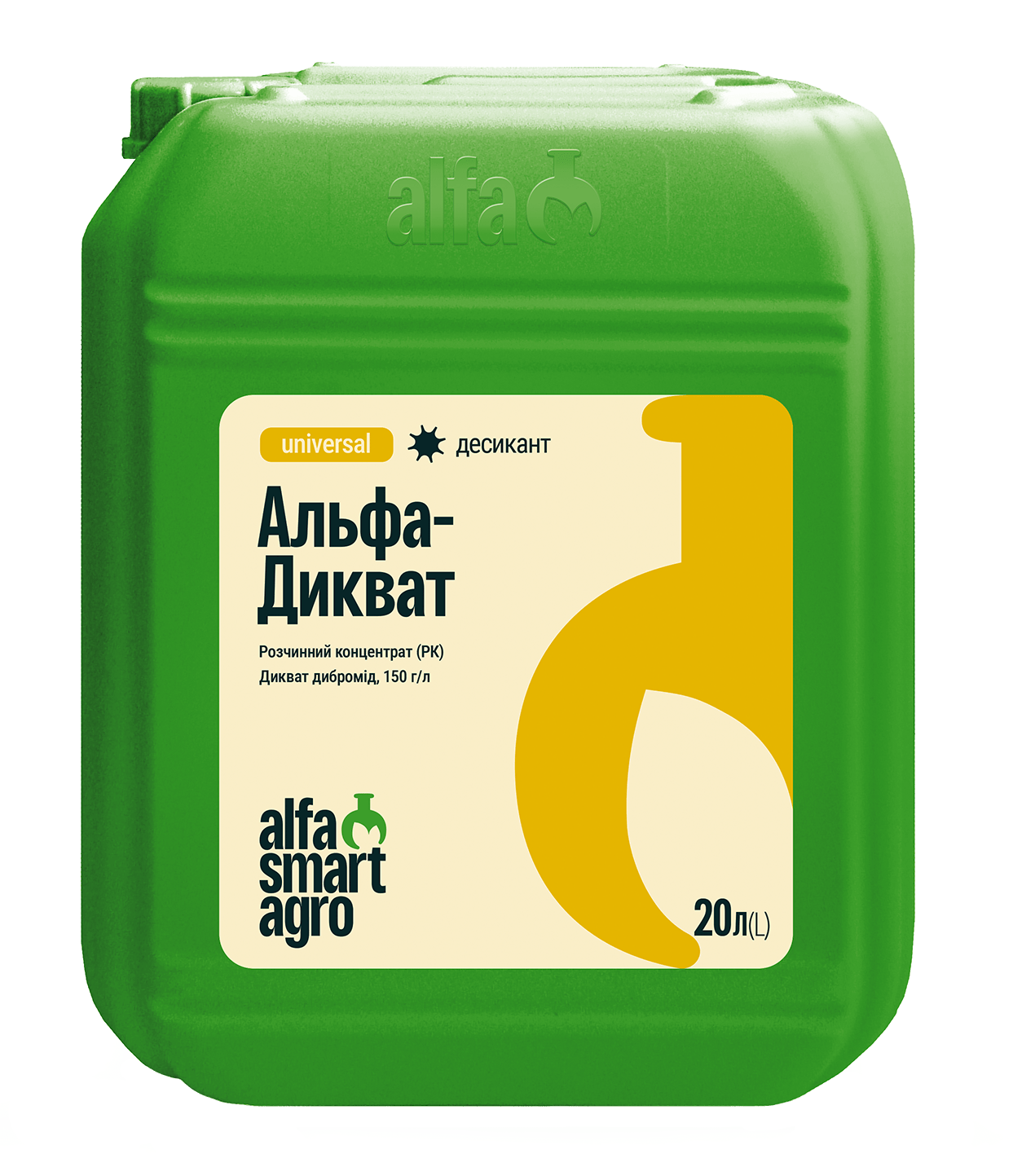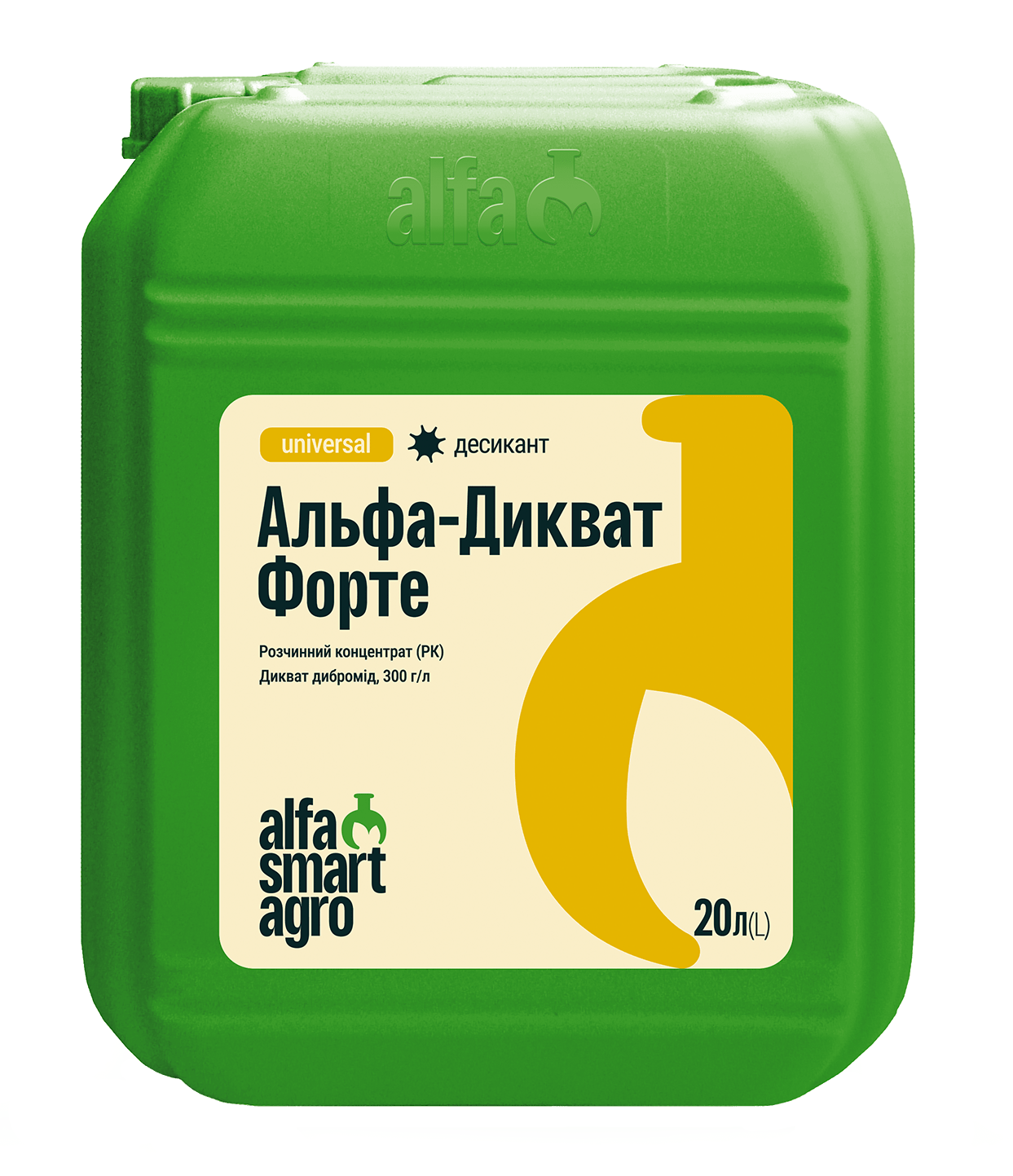Альфа-Дикват

Diquat dibromide, 150 g/l
It is quickly absorbed by plants and ensures rapid and uniform ripening, which allows for early and short-term harvesting. In addition to cultivated plants, it dries out weeds, which facilitates harvesting. It stops the development and spread of diseases (white and gray rot of sunflower). Diquat quickly
decomposes in plants, so the drug can be used on seed crops
areas and food crops.
The active ingredient diquat is rapidly absorbed by the green parts of plants
and is converted into hydrogen peroxide, which destroys the walls of cell membranes.
This leads to the drying of all green parts of the plant on which the drug has been applied.
Desiccation occurs only at the beginning of the photosynthesis process. But under the influence of
ultraviolet light, hydrogen peroxide decomposes quickly, so for
To ensure high efficiency, Alpha-Diquat treatment is recommended
should be carried out on a cloudy day or in the evening. In this case, more
deep penetration of diquat into the plant due to delayed cell destruction
before the photosynthesis process begins and more uniform desiccation is ensured.
The drug is used in sunflower crops in the browning phase of the baskets.
It is recommended to use only clean and filtered water, as
dirty water reduces the effectiveness of diquat. During application, the working speed
the unit should be 7-10 km/h. A mandatory requirement is to ensure
continuous coverage of the area and complete wetting of the plants during application
of the drug. It is recommended to carry out the treatment in the evening or during the day in cloudy weather. In sunny and hot weather, desiccation occurs quickly, but less
effectively. It is not recommended to process in the morning. It is forbidden to carry out
spraying at wind speeds of more than 3-4 m/s.
Tank mixtures with other commonly used pesticides on relevant crops
are not recommended due to mismatch in application times. To increase
desiccation efficiency, Alfalip surfactant should be added to the Alfa-Diquat solution
Extra (0.2-0.3 l/ha) or urea, ammonium nitrate.
- Rapid visible desiccation effect.
- Promotes faster and more uniform seed ripening, especially of late hybrids.
- Limits the spread of fungal diseases that lead to deterioration of seed quality (white, gray, dry rot, alternaria, mold).
- Low desiccation costs, high economic efficiency due to faster harvesting, reduced fuel consumption and drying costs.
Scope of application and cost norms
(registered in Ukraine)
| Culture | Appointment | Drug consumption rate, l/ha | Processing time | Waiting period, days | Max. number of treatments |
| Sunflower | Drying the crop and partial destruction of weeds | 2,0-3,0 | Spraying in the browning phase of baskets, including by aerial method | 6 | 1 |
Registration is planned for the following crops:
| Culture | Appointment | Drug consumption rate, l/ha | Processing method | Waiting period, days | Max. number of treatments |
| Crops | Drying the crop and partial destruction of weeds | 1,5-2,0 | 2 weeks before harvest, with grain moisture no more than 30% | 6-10 | 1 |
| Pea | 2,0-3,0 | During the period of yellowing of the lower pods, with grain moisture up to 45% | 7 | ||
| Soy | In the phase of the beginning of browning of beans of the lower and middle tiers, with grain moisture content not exceeding 35-40% | 6 | |||
| Rapeseed | 3,0 | When browning 70% crop pods | 7 | ||
| Linen | 2,0-3,0 | In the phase of early yellow ripeness of the crop | |||
| Potato | 1,5-2,0 | 10 days before harvest | 10 | ||
|
Fodder beans (seed crops) |
4,0-5,0 | During the period of yellowing of the seeds of lower beans | 8-10 | ||
|
Sorghum (seed crops) |
4,0 | During the waxy ripeness of seeds, with grain moisture content not exceeding 25% | 6 | ||
| Chickpea | 3,0-4,0 | In the phase of the beginning of browning of beans of the lower and middle tiers |


